When I tell you that the arrangement of sweetly colored textural shapes above is not art I sincerely hope you believe it. Admittedly, you have little reason to. You’ve been here before. You’ve seen that week after week I populate this space with images that are in fact art, or could, without too great a leap of imagination, be considered as such. High art, low art, unexpected art, unintentional art; Categorical labels and their attendant quotation marks, though generally eschewed, abound here for those who’d choose to employ them. This post though, is different. Truly. So when I assure you that the image above, and those to follow below are not art, have nothing whatsoever to do with art, and that when looking at them you probably ought to cringe and scowl, your nose ought to wrinkle, and you should turn away feeling vaguely disgusted, know that I mean it.
Contact (i)
Search (i)
Annex (i)
Special Projects (i)
Downloads (i)
Shop (i)
Archives (i)
Links (i)
Feeds: rss2 | atom (i)

This Post is Not About Art


Wit Larded with Malice
Or: The Satirical Russian Magazines of 1905-08
In Russia, following a string of embarrassing defeats in the Russo-Japanese War and the infamous Bloody Sunday incident, during the period of the so called Failed Revolution, no less than 480 underground magazines sprung-up to voice the outrage of the many disparate groups and factions and movements—nihilists, anarchists, socialists, Mensheviks, Bolsheviks, etc—which though unorganized, were united in their calls for Tsarist reform. This outpouring of printed materials, critical of the State, was no small thing in a country with a long history of strict censorship and brutal punishments for dissension. These many short-lived publications are referred to, collectively, as “satires.”
Today, when we (soft, fattened, fiddling Nero’s in miniature that we are) think “satire” we reflexively brace ourselves for the haw-haws. We think of Colbert and the Onion, or if we’re a bit older maybe Weird Al and Doonesbury, or MAD magazine and Dr. Strangelove. If we’re real oldenhiemers, with half a mind left, we might conjure fond memories of The Great Dictator and H.L. Mencken and a childhood of Twain stories and Thomas Nast reprints. In any case, for us, “satire” may as well be a straight-up 1-to-1 synonym for “funny.”
These Russian satires? Not so much.

Granted, I can’t read Cyrillic, and the million little contextual and cultural cues on display are obviously totally beyond me; I’m literally just looking at pictures. But one gets the sense looking over these underground turn-of the-century publications that the “satire” was here accompanied by an entirely different sort of wink. The closest equivalent I can think of, which might resonate for those living in a free and democratic society, would be the evocation of “satire” as a defense in an ugly slander lawsuit… if slander were punishable by death. Not much “comedy” involved. In these Russian magazines “satire” would seem, more than anything, a thin but precious barrier against open reprisal.
It’s said that these satires helped drive public opinion, to bring the criticisms which simmered just below the surface out into the open, and to force the first small concessions from the autocratic Tsar Nicolas II. Whether they in fact shamed the powers-that-be… it’s doubtful. I can say with certainty, however, that the graphic work in these publications, produced as they were under constant threat, does put most “underground” magazine work produced since to shame. The images, bleak and violent, mournful and angry though they are, remain powerful and terrifically beautiful.
Below, as illustration, I’ve reproduced a group of representative images culled from the book Blood & Laughter. Caricatures from the 1905 Revolution, by David King and Cathy Porter, put out in 1983.




Quote: “Bloody Sunday killed superstition, the old faith in a just Tsar, and unleashed a tumultuous rage among the masses… A huge wave of strikes swept the country, paralysing more than 100 towns and drawing in a million men and women. Throughout the summer peasants rioted while terrorists struck at figures of authority.
Alongside the struggle in street and factory was the struggle for the free press. Ministers and clerics suffered assassination more by the pen than the bullet as the revolution strove for the expression of powerful emotions long suppressed. A flood of satirical journals poured from the presses, honouring the dead and vilifying the mighty. Drawings of frenzied immediacy and extraordinary technical virtuosity were combined with prose and verse written in a popular underground language, veiled in allegory, metaphor and references to the past.”



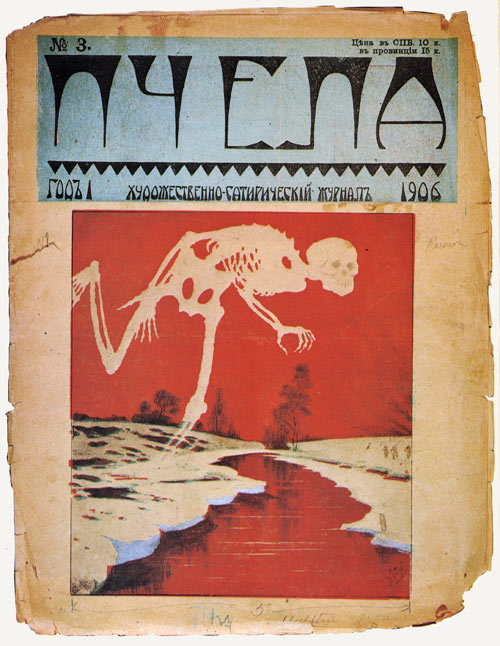
“Russia had a rich history of satirical journalism. In the 1770s, in the reign of Katherine the Great, an elite of intellectuals close to the court developed a new ‘aesopian’ language — deeply subversive to the enlightened autocracy — to express their opposition to the old regime. The satire of the court flourished until the shadow of revolution in Europe drove the Empress to suppress it. Again in the 1860s highly popular satirical journals sprang up, drawing consciously on their courtly predecessors to curse the Crimean War and Tsar Alexander ll’s empty promises of reform. While populist revolutionaries went ‘to the people’ to make common cause with the peasants, radical journalists set out to collect folk-stories, popular sayings, soldiers’ songs and workers’ ballads. The old allegorical vocabulary was joined to the language of popular satire. By the 1870s these journals had been closed down, but this language was now part of everyday speech. Satirical writing returned to the underground, where it flourished, rooted in popular protest, until 1905. It was then that satire achieved its full power.”
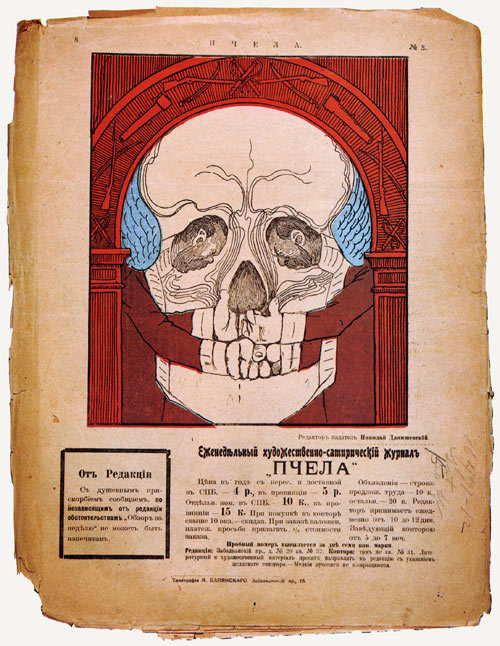



“Satire turned holy names into household names, it insulted authority and withered reputations. Yet although the journals enjoyed an almost fanatical popularity, most writers clung to the anonymity of the underground where, apart from a few who became well-known after the Bolshevik revolution, they tended to remain. The artists proclaimed their names more openly, and a number of them — like Isaac Brodsky, Alexander Lyubimov, Nikolai Shestopalov, Pyotr Dobrynin and Boris Kustodiev — went on to become prominent soviet painters. They and many other artists had all been students in the master-class of the great realist painter llya Repin. In February 1905 Repin and his students had marched together in a demonstration against the Bloody Sunday massacre, and from then on they had all turned to paintings of street demonstrations, meetings and peasant uprisings.”

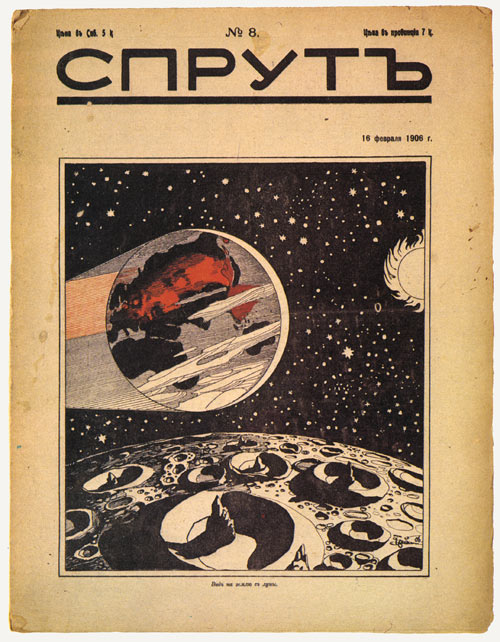
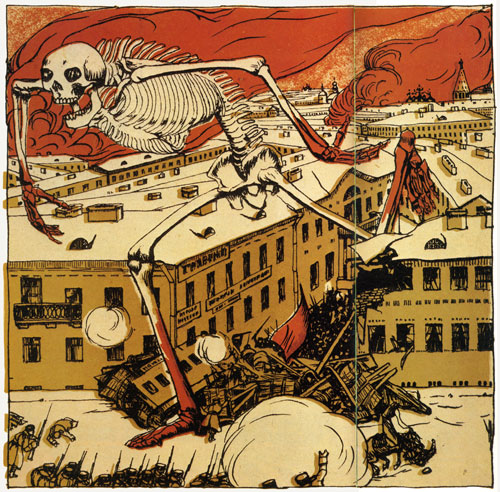
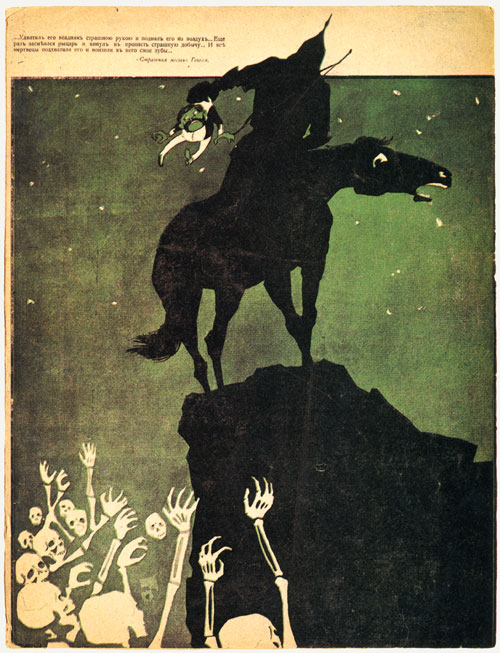
“For a few brief months the journals spoke with a great and unprecedented rage that neither arrest nor exile could silence. At first their approach was oblique, their allusions veiled, and they often fell victim to the censor’s pencil. But people had suffered censorship for too long.Satirists constantly expanded their territory and their targets of attack, demolishing one obstacle after another as they went, thriving on censorship. The workers’ movement grew in boldness, culminating in the birth of the St Petersburg Soviet of Workers’ Deputies, the people’s government. For fifty days the Tsar and his ministers were confronted by another power, another law. Journalists and printers seized the right to publish without submitting to the censor. The satirical journals then reached their apotheosis, until the revolution died as it had risen, bathed in blood.” -Cathy Porter, from her introduction to Blood & Laughter ,1983.
Well…
Apparently slaughter and hunger and class-struggle and brutal autocratic oppression aren’t very amusing when you get right down to it. On the other hand, perhaps for their intended audience these were amusing. Perhaps the simple but revolutionary act of speaking out against an oppressor was powerful enough to make even of a pile of human skulls feel exuberantly therapeutic. As a westerner, living a century later, totally removed from the language and culture and context I can’t rightly say. I mean, Russian humor has always had a slightly darker more grim cast than that of the West hasn’t it? Perhaps these “satires” offer a tiny clue as to why that might be.
If you’d like to see more of these Russian Satires the Yale University Beinecke Rare Book & Manuscript Library has a very nice group of page scans, including interiors. Simply search for “Russia 1905.” Likewise, for more detailed information the Blood & Laughter. Caricatures from the 1905 Revolution is highly recommended.
Hope you enjoyed.
hide full text

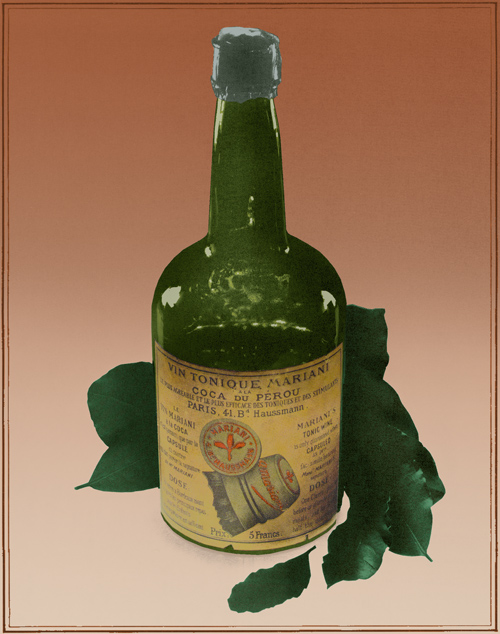
Vin Mariani
“never has anything been so highly or justly praised.”
A good 20 years before the original cocaine-infused Coca-Cola taught the world to grind its teeth and give ineffectual bathroom-stall handjobs in per•fect har•mo•ny, there was another drink of choice among those wishing to feel invigorated and overconfident for no good reason. It was called “coca wine” and it was loved not only by self-important blowhards wearing too much jewelry but by Kings and Popes and… oh, right. Anyhow, it was called Vin Tonique Mariani (or simply Vin Mariani) was sold as a curative, and in the latter half of the 19th century it was a medicinal, recreational, and marketing powerhouse. To paraphrase J.J. Cale “Czars don’t lie, Popes don’t lie, Queens don’t lie…”
In 1863, after having read a paper by Paolo Mantegazza (the man who first isolated cocaine from coca leaves) on the effects of the coca leaf, and seeing the economic potential, Angelo Mariani, a corsican chemist, set to work creating a “tonic” of his own. The resultant coca wine, a Bordeaux treated with coca leaves, was the first recreational cocaine product brought to market. It’s formula evidently yielded a drink which was 10% alcohol and 8.5% cocaine extract by volume.
Typical table wine, today, has an alcohol content of approximately 8-14%, so Vin Mariani falls squarely in the average. Not a fortified rotgut or anything. As for the 8.5% cocaine extract… I don’t really know how to compare that number. It’s more than the 7% Holmes liked to shoot? It doesn’t matter much, however, because evidently it wasn’t specifically the alcohol or the cocaine percentages which made Vin Mariani so potent, but rather the chemical combination of the two.
Quote: “If cocaine is consumed on its own, it yields two principal metabolites, ecgonine methyl ester and benzoyleconine. Neither compound has any discernible psychoactive effect. Cocaine co-administered with alcohol, however, yields a potent psychoactive metabolite, cocaethylene. Cocaethylene is very rewarding agent in its own right. Cocaethylene is formed in the liver by the replacement of the methyl ester of cocaine by the ethyl ester. It blocks the dopamine transporter and induces euphoria. Hence coca wine drinkers are effectively consuming three reinforcing drugs rather than one.” -Cocaine.org

Needless to say this tonic was a hit. So much so that Angelo began using its popularity among “notable personages” as a main selling point. His advertisements still extolled the curative virtues of the product, “renewing, invigorating, nourishing, strengthening, refreshing,” etc…




But damn near every product of the time made similar claims didn’t they? What made Vin Mariani really stand out (aside from the addictive narcotic high, obviously) was Angelo’s celebrity media blitz, a positively banal tactic in todays advertising landscape but, in the 1860’s, almost certainly the first marketing campaign of its kind.
Quote: “Mariani introduced his coca wine in the mid-1860s. By the mid-1880s he was the largest importer of coca leaves in Europe, and his Vin Mariani the most avidly endorsed tonic on both sides of the Atlantic. Testimonials from eminent personages were so numerous that Mariani, as great a public relations man as he was a chemist, published them in handsome leather-bound volumes—replete with portraits and biographical sketches of the endorsers.


Those present included the Prince of Wales, the czar and czarina of Russia, the kings of Norway and Sweden, the commanding general of the British Army, and Pope Leo XIII, who, after many years of sipping Vin Mariani, cited Mariani as a “benefactor of humanity” and presented him with a gold medal.



Some 8,000 doctors swore to the virtues of Vin Mariani. And Dr. J. Leonard Corning of New York, the first surgeon to use cocaine for spinal anesthesia, testified that ‘Of all the tonic preparations ever introduced to the notice of the profession, this is undoubtedly the most potent for good in the treatment of exhaustive and irritative conditions of the central nervous system.’
Alexandre Dumas, Jules Verne, Emile Zola, Henrik Ibsen, and other renowned authors were equally lavish in their praise of Vin Mariani. Bartholdi, sculptor of the Statue of Liberty, wrote that this ‘precious wine will give me the strength to carry out certain other projects already formed.’



Thomas Edison, a man who slept only four hours a day, was a steady user. The secretary of President McKinley noted that a case of Vin Mariani had received an enthusiastic reception by the president. The physicians of Ulysses S. Grant wrote that Mariani products had given the sick general and former president the strength to work several hours a day on his memoirs. And Queen Victoria was so pleased to receive a set of Mariani testimonial volumes that she wrote the master that she considered them among the finest specimens in her collection.” -High Times Encyclopedia of Recreational Drugs, 1978.


The success of Mariani’s wine inspired many imitators, the most famous being, of course, John Smyth Pemberton who’s “Pemberton’s French Wine Coca” would survive various American prohibition laws, the 1906 Pure Food and Drug Act, and growing public anxiety over the addictive qualities of cocaine to become Coca-Cola. Vin Mariani was not as fortunate.
Today, barring some homemade preparation by intrepid psychonauts, the closest you’re likely to get to that original “renewing, invigorating, nourishing, strengthening, refreshing” Mariani high would be through the Peruvian grown, Vin Mariani branded, “coca wine” being produced by the UK company, Mariani Amalgamated, Ltd., and one would have to assume that’s not very close at all. As for the over-the-top celebrity marketing campaigns and the doctor-prescribed highs… hey, no problemo man, we’re cool.
Hope you enjoyed.
hide full text

Occult Chemistry
In 6th century BCE the concept that matter is composed of discrete and not infinitely reducible units developed in India. Around 460 B.C. the Greek Democritus named these fundamental and irreducible bits of matter átomos, meaning “uncuttable.” Notions of this kind were at this point in history, more than anything, matters of pure Philosophy. As such, when the big daddy Aristotle weighed in and rejected the idea as worthless, “the atom” was pretty much stopped in its tracks. It would be a couple thousand years before Science picked up where Philosophy had left off. But before Science made its first excited indirect observations of electrons and protons and managed to put forward a widely acceptable model for the structure of the atom, another group stepped forward to ply their trade in the service of atomic knowledge. They were theosophists, known collectively as the Occult Chemists, and their goal was nothing less than “direct observation of atoms through clairvoyance.”
In 1878 one Dr. Edwin D. Babbitt, proponent of “chroma therapy,” (and granddad of the current duck’s nest of “color therapy”) created for his book Principles of Light and Color and Religion As Revealed by the Material and Spiritual Universe a visualization of the atom which, lunatic and fictional though it may be, is, I must admit, pretty stunning.
See below.

A wild concoction of spirals and vortexes which ties up Babbit’s arguments on bonding, heat, electricity, light, color, friction, and psychic power all in a single unmistakably heart-shaped package. Love it. As it happens the Occult Chemists did not.
Charles Webster Leadbeater, Mrs. Annie Besant, and Curuppumullage Jinarajadasa, the Occult Chemists, having seen the atom first hand through clairvoyance as early as 1895, felt assured in commenting:
Quote: “The illustrations there given of atomic combination are entirely wrong and misleading, but if the stovepipe run through the centre of the single atom be removed, the picture may be taken as correct, and will give some idea of the complexity of this fundamental unit of the physical universe.” -Mrs. Besant, 1909.
They called their vastly different fundamental particle the Anu, which they revealed in the 1909 publication titled, Occult Chemistry, a series of Clairvoyant Observations on the Chemical Elements. The Anu looked like this-

Hmmmmmm. Ahem.
Though ye of the untrained (third) eye might want to yell out, “Hey! that looks, like, exactly the same!” rest assured it is totally different.
Anyhow, this Anu was only the tip of the iceberg as the group went on the describe and visualize a plethora of elements, delving into the structures and relationships in gloriously delusional detail. They were not mere reporters either, their investigations yielded information on matter hitherto unknown! For instance, the element they observed, having an atomic weight of 3 and taking a place on the periodic table between Hydrogen and Helium, which they named… wait for it… Occultum.
Indeed these were the trailblazers of second-sight microscopy.
Below, for your educational edification and viewing pleasure I’ve reproduced a sampling of their findings. Keep in mind when perusing these, however, that…
Quote: “It is, of course, impossible to convey by words the clear conceptions that are gained by direct vision of the objects of study, and the accompanying diagram—cleverly drawn from the description given by the investigators—is offered as a substitute, however poor, for the lacking vision of the readers.” -Mrs. Besant, 1909.
We poor bastards lacking in vision will just have to suffice I suppose.

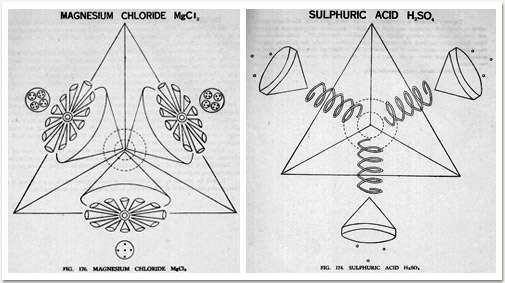








So? Do you believe them? I don’t think they much expected you to. Being occult scientists they were fully aware of the importance of repeatability and in as much leave the corroboration to you.
Quote: “The method of examination employed was that of clairvoyance; there were only two observers - Mr. Leadbeater and myself - and it is very desirable that our results should be tested by others who can use the same extension of physical sight. The researches being carried on upon the physical plane - the forms examined being gaseous and etheric only - a very slight intensification of ordinary vision is all that is necessary, and many should, therefore, be able to test our observations. They cannot be regarded as established, by the outside world, until others have corroborated them; and we put them forward in the hope of stimulating work along this line, and of thus bringing to science, when its instruments fail it, the old, old instrument of enlarged human vision.” -Mrs. Besant, 1909.
Yes indeed. Better get to work ay?
-
I ought to say that initially I intended to do a lengthy write-up on this subject and its protagonists, but as tends to be the case when attempting to delve into the more arcane founts of knowledge, after about 20 minutes the whole mess just starts reading like brain-sapping gobbledygook. So I hope you feel satisfied with this illustrated, albiet very shallow, surface scratching. Anyone brave, brain damaged, or patient enough can of course delve deeper on their own.
For many more images, some context, and much more specific information see the following:
Serious Scientific Lessons from Direct Observation of Atoms through Clairvoyance by J. Michael McBride, Yale University.
Occult CHemistry, Investigations by Clairvoyant Magnification into the Structure of the Atoms of the Periodic Table and Some Compounds by C. W. Leadbeater & Annie Besant.
Occult Chemistry by Anad Gholap.
Religion as Revealed by the Material and Spiritual Universe By Edwin Dwight Babbitt.
Information on the 7 dimensions, the Anu, John Keely, atomic and subatomic particles!
Subtle Energy and Energy Medicine: New Paradigms, New Technologies, New Possibilities
What does an atom look like?, from Hydrogenlab.de
Until next time.
hide full text




